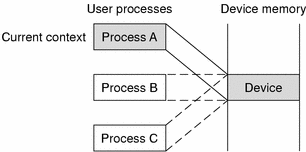Introduction to Device Context
This section introduces device context and the context management model.
What Is a Device Context?
The context of a device is the current state of the device hardware. The device driver manages the device context for a process on behalf of the process. It must maintain a separate device context for each process that accesses the device. The device driver has the responsibility to restore the correct device context when a process accesses the device.
Context Management Model
An accelerated frame buffer is an example of a device that allows user processes (such as graphics applications) to directly manipulate the control registers of the device through memory-mapped access. Because these processes are not using the traditional I/O system calls (read(2), write(2), and ioctl(2)), the device driver is no longer called when a process accesses the device. However, the device driver must be notified when a process is about to access a device so that it can restore the correct device context and provide any needed synchronization.
To resolve this problem, the device context management interfaces enable a device driver to be notified when a user process accesses memory-mapped regions of the device, and to control accesses to the device's hardware. Synchronization and management of the various device contexts are responsibilities of the device driver. When a user process accesses a mapping, the device driver must restore the correct device context for that process.
A device driver will be notified whenever a user process:
-
Accesses a mapping
-
Duplicates a mapping
-
Frees a mapping
-
Creates a mapping
Figure 13–1 shows multiple user processes that have memory-mapped a device. The driver has granted process B access to the device, and process B no longer notifies the driver of accesses. However, the driver is still notified if either process A or process C accesses the device.
Figure 13–1 Device Context Management

At some point in the future, process A accesses the device. The device driver is notified of this and blocks future access to the device by process B. It then saves the device context for process B, restores the device context of process A, and grants access to process A, as illustrated in Figure 13–2. At this point, the device driver will be notified if either process B or process C accesses the device.
Figure 13–2 Device Context Switched to User Process A

On a multiprocessor machine, multiple processes could be attempting to access the device at the same time. This can cause thrashing. Some devices require a longer time to restore a device context. To prevent more CPU time from being used to restore a device context than to actually use that device context, the minimum time that a process needs to have access to the device can be set using devmap_set_ctx_timeout(9F).
The kernel guarantees that once a device driver has granted access to a process, no other process will be allowed to request access to the same device for the time interval specified by devmap_set_ctx_timeout(9F).
- © 2010, Oracle Corporation and/or its affiliates
